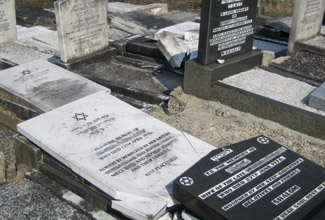LONDON, July 19 (JTA) — An unprecedented collaboration between a British Jewish think tank and London’s Metropolitan Police has produced research that both hope can be used to develop new strategies to combat anti-Semitic crimes. The Institute for Jewish Policy Research teamed up with British police to produce the most comprehensive analysis to date of incidents over the past three years in which Jews have been targeted in London. “It’s groundbreaking research,” said Mike Whine of the Community Security Trust, the body that has monitored and recorded threats to Jews in the United Kingdom since 1984. “It’s the first time the police have given an outside researcher access to work with their own criminologists.” The study aims to take a closer look at the nature and social context of anti-Semitic incidents, providing tools for understanding the motivations for racial attacks and working to prevent them in the future. The Metropolitan Police Service “works with a range of communities in London,” said Commander Steve Allen, who heads its diversity directorate. “This research will help us strengthen the service that we deliver to victims of hate crimes, as it gives us increased understanding of offenders and the crimes they commit.” British Jewish leaders agreed. “Police forces are very sensitive, especially in areas with a large Jewish population,” said Jon Benjamin, the chief executive of the Board of Deputies, the representative body of Anglo Jewry. The Jewish community, particularly through the Community Security Trust, has “a very good relationship with the police, which needs to percolate down to the streets and up through the criminal justice system.” Two police criminologists, Susan Paterson and Vicky Kielinger, joined Paul Iganski, a fellow at the Jewish research institute, to examine the 1,296 anti-Semitic incidents reported to police between January 2001 and December 2004. They mapped their nature and location, the characteristics and motivations of the offenders, and the events that might have spurred the incidents. “Understanding the everyday dynamics of hate crime is important for policing it effectively,” said Iganski, a lecturer in sociology and criminology at the University of Essex. The team found that the number of anti-Semitic attacks in the United Kingdom — with one in six involving violence — might be much greater than previously thought. In 2004, the trust recorded 532 incidents, its highest annual total and a 42 percent increase from the previous year. But the joint research shows that the combined number of attacks reported to police and the trust proved to be higher than the number each agency recorded separately, suggesting that victims tend to inform either the police or the trust, but not both. “There is under-reporting,” Whine said. “Our figures show an increase more or less year-on-year since the intifada began in 2000.” Even when incidents were reported, less than one in 10 resulted in a suspect being charged or cautioned or having proceedings brought against him or her. Benjamin said there were further concerns about the many opportunities for the racial-hatred element to disintegrate during a prosecution, because of plea bargains or the fact that it’s easier to win a successful prosecution on lesser charges. “That means cases might end with a conviction for simple assault or criminal damage,” he said. “We lose a very important opportunity to send a message out to the wider community that this kind of thing can’t be tolerated.” The study reinforces the link between heightened tensions in the Middle East and violence against Jews in the United Kingdom. That link had been highlighted in a trust report that showed that after the Palestinian intifada began in September 2000, attacks the next month soared to 105, the highest monthly total in five years. After the Israeli military assassinated the Hamas leader Sheik Ahmed Yassin in March of last year, 100 anti-Semitic incidents followed, including 54 recorded within 48 hours of Yassin’s death. During April and May of 2002, around the time of Operation Defensive Shield, the massive Israeli antiterror incursion into the West Bank, researchers found that one in five incidents involved anti-Israel sentiment. “Anti-Semitic incidents, like hate crimes in general, do not occur in a vacuum,” Paterson said, emphasizing the importance of examining background environments. “They occur in a cultural context where bigotry and, in some instances, violence are used by offenders to make their targets more vulnerable.” Kielinger said the research highlighted patterns in attacks against Jews that she hoped would contribute to international debates on hate crime. “Our research suggests that most anti-Semitic incidents recorded by the police do not appear to be carried out by perpetrators associated with organized or extremist groups but instead occur as part of the dynamics of everyday life.” “The pattern of attacks has changed too,” Whine added. “In the last few years there have been peaks and troughs corresponding to the Israeli-Palestinian situation. Now there is a continuous high level. Anti-Semitism is becoming structural rather than transient.” Pointing to the desecration of two Jewish cemeteries within 72 hours of each other last month, Barry Kosmin, the executive director of the Jewish research institute, described the report as a “particularly timely” piece of criminological research that gave substance “to growing concerns about the rise of local, national and global anti-Semitism.”
Report: Anti-Semitic attacks up in Britain

Tombstones damaged by vandals at the Rainsough Cemetery, a Jewish cemetery in Manchester, England, in June 2005. (Courtesy of Community Security Trust )
Advertisement





